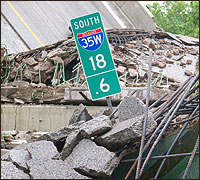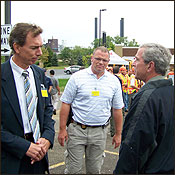‘A MEASURED RESPONSE’
Our Role in Bridge Probe, Part III
08/24/07
 |
| The I-35W bridge in Minneapolis collapsed August 1, setting in motion setting in motion a well-rehearsed protocol for responding to worst-case scenarios. |
Tim Gossfeld, Assistant Special Agent in Charge of the FBI’s Minneapolis field office, was heading out the door August 1 when a night clerk informed him, “I-35W just fell into the Mississippi River.” The eight-lane span fell at 6:05 p.m., the height of rush-hour, setting in motion a well-rehearsed protocol for responding to worst-case scenarios.
“At 6:15 we didn’t know what we were dealing with,” Gossfeld said in an interview a week after the bridge fell, killing more than a dozen people and cutting off a major route through the middle of the city.
At first, there were no apparent signs of terrorism, but investigators operate by assuming all possibilities and then systematically ruling them out. In a case where terrorism is a possibility, there’s no time to waste.
 |
| Minneapolis ASAC Tim Gossfeld, left, meets with President Bush near the bridge site on August 4. More Images |
“You can’t as an investigator afford to lose any time getting back up to speed in a terrorism investigation,” Gossfeld said. “You don’t want to find out about a terrorism nexus two weeks, two days, or even two hours down the road.”
Agents and analysts immediately began working leads, some heading to the bridge site to lend assistance to local rescue crews and query victims about exactly what they saw and experienced. Gossfeld drove to a command post established by the Minneapolis Police Department, which was in charge of the coordinated response—a well-oiled protocol established in drills and exercises involving federal, state, and local law enforcement and emergency personnel.
“These were all guys we knew,” Gossfeld said, recalling the ease in coordinating a response, including the FBI’s role supporting the Hennepin County Sheriff’s Office in rescue and recovery operations on the river and the National Transportation Safety Board in evidence collection related to their federal bridge collapse probe.
“In the early hours of the investigation, you don’t jostle with your partners,” Gossfeld said. “We huddled often—almost every 20 minutes—standing in a circle and coordinating our various efforts.”
As rescue workers were tending to victims, we had bomb technicians working with Bureau of Alcohol, Tobacco, Firearms and Explosives (ATF) agents and their bomb-sniffing dogs walking the structure looking for signs of an explosion. Our Critical Incident Response Group had activated the Strategic Information and Operations Center at Headquarters to support the Minneapolis office’s growing workload. Agents interviewing victims on the bridge were taking statements and listening for “tripwires”—an explosion? anything suspicious?—that might alter the course of the investigation.
“In the first hour, you don't know the enormity of the overall situation,” Gossfeld said. “We needed answers quickly.”
Meanwhile, agents and analysts were monitoring various tip lines for leads and claims of responsibility. "We wanted to be aware of any potential claim that came in," Gossfeld said, adding that bogus claims were not uncommon from individuals trying to capitalize on tragic situations.
Based on the preliminary investigation, Gossfeld and his team deduced it was unlikely that the bridge collapse had been an act of terrorism. A coordinated statement was released to inform the public of the early assessment.
In the days that followed, our role turned to supporting local and federal partners on a case that would reverberate locally and nationally—the efforts to find families’ lost loved ones and to help determine what caused a bridge not unlike many others in the U.S. to suddenly collapse.
“Any way that we could help out, we wanted to help out," Gossfeld said. "What we wanted to accomplish here with our liaison partners was a measured FBI response—appropriate under the circumstances that had developed, but mindful of our counterterrorism responsibilities."
Resources:
- Our Role in the Bridge Probe, Part 1
- Our Role in the Bridge Probe, Part 2
- Photo Gallery: Our Role in the Bridge Probe


